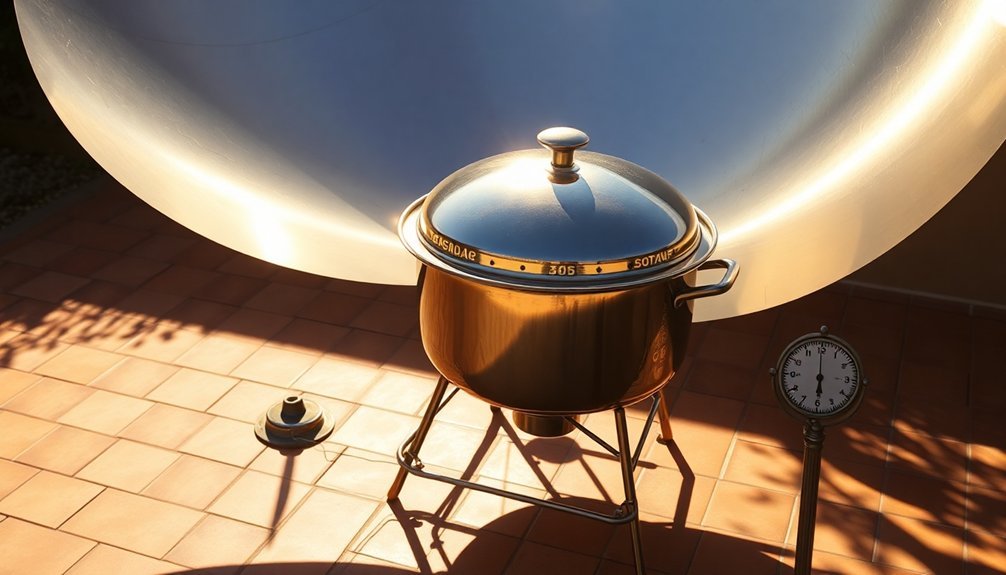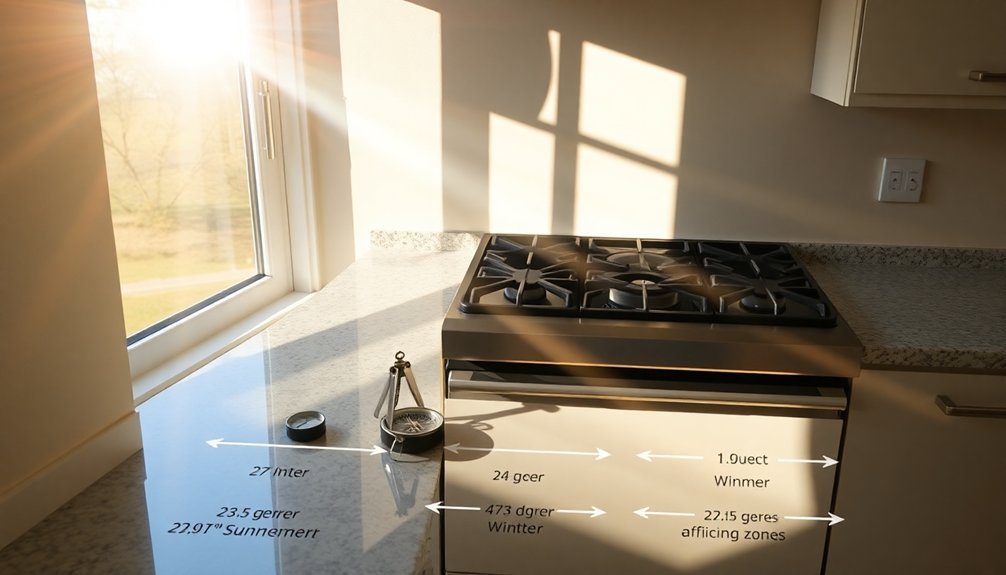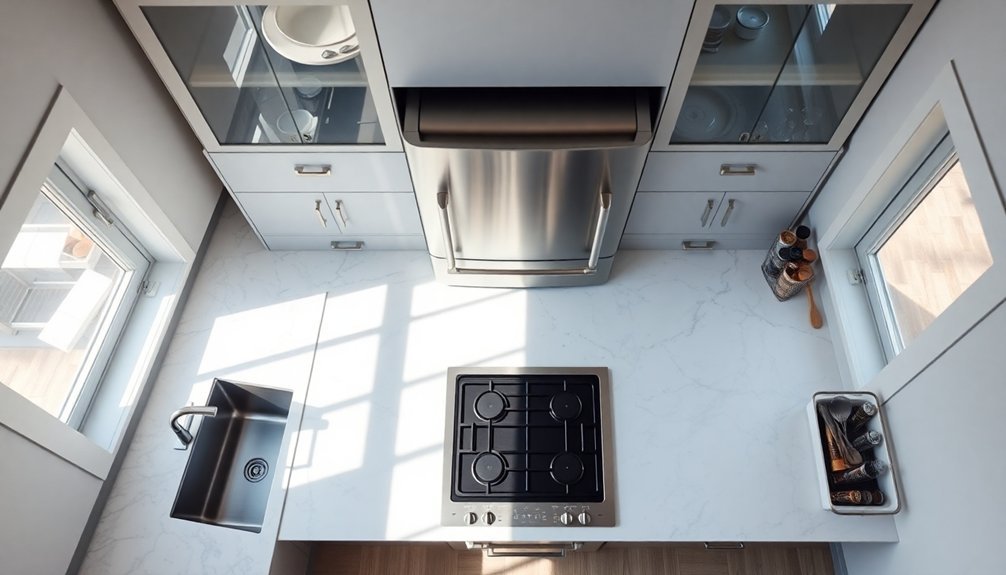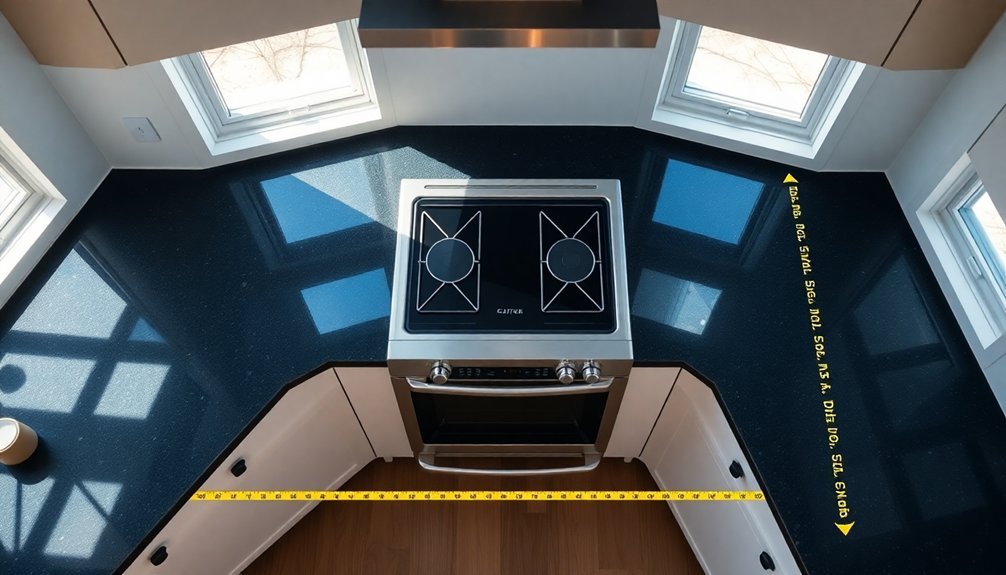Position your solar cooker at angles that maximize sun exposure throughout the day for peak efficiency. You'll want to face it due south and tilt between 18-68 degrees, depending on your latitude and season. During winter, increase the tilt by 15-20 degrees; in summer, decrease it by the same amount. Adjust your cooker's position every hour to follow the sun's 15-degree movement across the sky. For best results, cook between 10 AM and 4 PM when sunlight is strongest. Keep mirrors at complementary angles to concentrate heat effectively. Understanding the nuances of positioning can boost your cooker's performance by up to 40%.
Optimal Sunlight Catching Position

When positioning your solar cooker for perfect sunlight exposure, you'll need to take into account both the sun's altitude and your geographical location. The sun's angle varies throughout the day and seasons, making regular adjustments necessary for peak performance.
If you're in northern latitudes, you'll face greater challenges due to lower sun angles, especially during winter months. For example, in Ottawa, the sun's altitude drops from 68 degrees at noon in June to just 18 degrees by late afternoon in April. The best cooking times are typically between 10 and 4 when the sun is strongest.
Position your cooker facing due south to maximize sun exposure throughout the day, and adjust its tilt to match the sun's current angle. Choose a sheltered spot to protect against wind, and don't forget to wear sunshades when working with reflectors.
Guarantee proper insulation to maintain cooking efficiency in colder weather.
Mirror Placement For Heat Collection
The strategic placement of mirrors transforms your solar cooker from a basic heat collector into a powerful cooking system. For maximum efficiency, you'll want to position your mirrors at carefully calculated angles that direct sunlight onto the absorber plate.
If you're using a concave mirror, place it to concentrate solar energy from a large area into your cooking zone. The blackened inner surfaces help maximize heat absorption in the cooking chamber. For plane mirrors, set them at an adjustable inclination to boost solar radiation onto the absorber plate.
You'll need to modify these angles based on your latitude and the season. Remember, the angle of incidence equals the angle of reflection, so align your mirrors to create an ideal reflection path.
Consider adding a booster mirror for enhanced performance, especially during winter months when sunlight is less direct.
Seasonal Solar Angle Adjustments

Since the sun's position changes throughout the year, you'll need to adjust your solar cooker's angle to maintain peak performance.
For ideal results, set your cooker's angle steeper in winter (add 15-20 degrees to your latitude) and shallower in summer (subtract 15-20 degrees from your latitude).
If you're using a box cooker, you can adjust its reflector panels seasonally. Placing your solar cooker where there are no shadows present throughout the day ensures optimal performance.
While panel and funnel cookers have limited adjustability, parabolic cookers need more frequent tweaking but perform better year-round.
You might consider owning multiple cooker types to switch between seasons.
Making 4-5 angle adjustments annually can boost your cooker's efficiency considerably.
If you're unsure about the best angle, use online calculators or consult professionals who can factor in your specific location and conditions.
Daily Tracking And Rotation
Proper daily tracking enhances your solar cooker's performance beyond seasonal adjustments.
You'll need to follow the sun's 15-degree hourly movement to maintain peak cooking temperatures. For box-style cookers, position your reflectors at a 30-degree angle when the sun's overhead, and adjust them every hour.
During morning hours, keep your sunward reflector horizontal while the opposite reflector leans 30 degrees toward the sun.
At midday periods (9 AM or 3 PM), set your sunward reflector 30 degrees above horizontal with the opposite reflector vertical.
If you're using an automatic tracking platform, it'll handle these adjustments continuously. For manual systems, check your alignment every 20 minutes for best results.
Kitchen Zone Setup Fundamentals

Five essential zones form the foundation of an efficient kitchen layout: cooking, prep, cleaning, food storage, and non-consumable areas. When you're positioning your cooker, you'll want to guarantee it fits seamlessly within this zoning system.
Your cooking zone should connect naturally to your prep area, where you'll keep essential tools like mixing spoons and pots in nearby drawers. Position these zones as part of a work triangle with your sink, maintaining a total perimeter of 13-26 feet.
You'll want to avoid any obstacles between these key points. Store your cooking equipment close to where you'll use it, and guarantee proper ventilation around your cooker.
Don't let major traffic paths cross through your work triangle, as this will disrupt your cooking flow and efficiency.
Frequently Asked Questions
How Do Weather Conditions Affect the Optimal Positioning of Solar Cooker Panels?
You'll need to adjust your solar panels during clouds, wind, and rain. Tilt them steeper in snow, angle them away from strong winds, and reposition them frequently on cloudy days for maximum sunlight capture.
Can Multiple Solar Cookers Be Positioned Together Without Creating Shadow Interference?
Yes, you can position multiple solar cookers together by spacing them at least twice their shadow length apart and aligning them east-west. You'll need to maintain proper gaps to prevent shadow overlap.
What Backup Angle Positions Work Best During Partially Cloudy Conditions?
You'll want to aim your cooker toward where the sun's strongest (usually 1-2 PM), even with clouds. Position it to capture diffused light and adjust periodically. Expect longer cooking times in cloudy conditions.
How Does Altitude Above Sea Level Impact the Recommended Cooker Angles?
At higher altitudes, you'll need steeper tilt angles since there's less atmospheric interference. Add 5-10 degrees to your standard angle for every 1,000 feet of elevation to maximize the direct solar radiation.
Does Reflective Ground Surface Material Influence the Ideal Positioning Angles?
No, your reflective ground material won't change the ideal positioning angles. While different materials affect overall efficiency, you'll still need to follow the same angle calculations based on the sun's position.
In Summary
You'll get the most from your solar cooker by mastering these five positioning angles. Whether it's catching direct sunlight, using mirrors effectively, adjusting for seasons, tracking the sun's daily path, or setting up your kitchen zone, these fundamentals will maximize your cooking efficiency. Remember to check and adjust your cooker's position regularly – it's the key to consistent, energy-efficient solar cooking results.





Leave a Reply